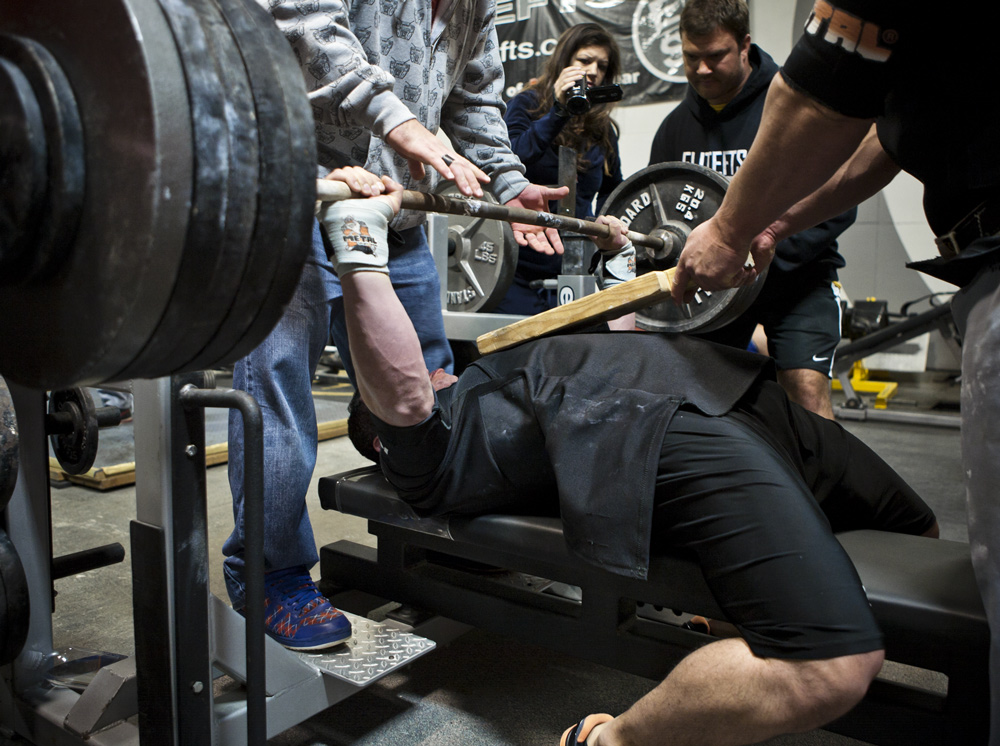
This is really one of the best problems to have and the easiest to fix. When you’re dealing with sticking points in the bench press you have to remember that there are several ways to correct the problem, but most won’t work for you. So don’t beat a dead horse! In other words, if what you’ve been doing isn’t working, then try something else. You have plenty of ammo. I’ve had this same problem with my bench and sometimes it takes years to stumble upon the right movement to fix the problem. Other times I hit the right movement the first time out.
1.) Get your head right. This is true with all sticking points regardless of the point at which you stall out. If you believe you always miss at the top, then you’ll always miss at the top! Your mind has a lot to do with your sticking points. I try to teach all the athletes I work with to visualize their sticking point at a higher position and focus very hard on driving the bar through it. In other words, when you bench you must focus on pushing the bar very fast through your sticking point. Focus will make a big difference.
2.) Learn to use your triceps. This is done by keeping your body tight and focusing on pulling the bar apart. This will involve your triceps more throughout the movement and keep the bar moving in a straight line. A good trick to teach you to do this is to use an EliteFTS mini band. You double the band up and wrap it around you wrists while you bench. This forces you to pull the bar apart and grasp the barbell tight. If not, your hands will be shot together. Pull the bar apart and watch that sticking point disappear!
3.) Start the bar where you want to finish. This is a very simple concept but it’s very seldom practiced. Most lifters will unrack the bar and lower it to the chest without setting the bar first. This is usually done by habit and will cause you to lower the bar in a diagonal pattern that will result in you pushing it back up in the same pattern. When you push the bar back toward the rack there’s more rotation and less emphasis on the triceps.
You need to unrack the bar, then "set it" in the same exact position in which you want to finish. This should be directly above where you lower the bar. If you bench to your lower pecs then the bar must start above the lower pecs. This will create a straight line both on the eccentric and concentric. Remember, the shortest distance between two points in a straight line.
4.) Move the bar fast. You need to make sure you’re pressing as fast as possible to bust through your sticking point. A slow press won’t build enough momentum to bust past your sticking point. If you’re trying to open a stuck door would you try to open it slowly or would you bust into it as hard as possible? Speed is key!
5.) Strengthen the top half. There are several movements that can help you strengthen the muscles that lockout the bench. These are best done using the max effort method. This is the method where you work up to a one or three-rep max on the movement.
The best movement for a weak lockout is a three or four board press. A board press is preformed by using three or four 2 x 6 boards placed on your chest. Lower the bar to the boards, pause and press back up. In extreme cases you may want to use a set of mini bands on the bar as well.
A second movement that works very well is the floor press with the use of chains. The floor press is performed the same as the bench press except you’re lying on the floor. Work up to about 60 to 70% of your best bench, then begin adding one set of chains on the bar with each additional set. You fail when you can no longer add any more chains.









